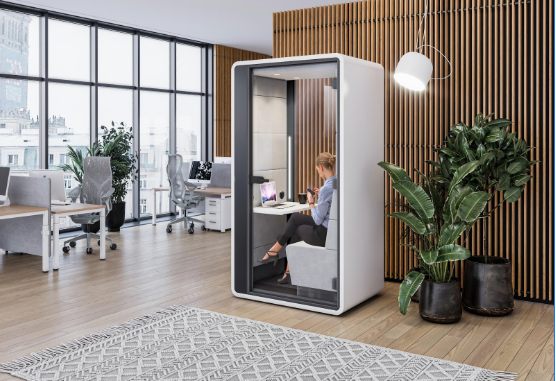
In companies where employees most often perform their duties in open-plan offices, confidentiality and discretion become particularly sought-after values. It is worth noting that privacy at work is multifaceted – it is divided into acoustic, visual, and architectural aspects. Understanding what they are is key to creating spaces conducive to effective functioning and comfort. That’s why more and more organizations are looking for solutions to balance the need for collaboration with privacy. Read the article and learn how to ensure acoustic, visual, and architectural confidentiality in open space offices.
What is acoustic privacy?
Acoustic privacy in an office space has two dimensions. It refers to the creation of working conditions that minimize sound interference and limit its penetration between different office zones. Noise in the background of an open space, which hinders concentration and efficiency at work, is generated not only by people, but also by various types of equipment. The second aspect relates to speech privacy, sometimes also called acoustic confidentiality. During team meetings or video conferences in particular, it allows participants to share information without fear of being overheard.
How to take care of acoustic privacy for employees in the office
The essence of acoustic privacy is to both reduce noise levels and provide optimal sound insulation. This translates into better working conditions and team performance. In practice, this can be achieved through the use of specialized insulation materials, the arrangement of office space, and the introduction of innovative solutions such as Hushoffice acoustic booths. The office cubicles for individual and collaborative work, thanks to the use of materials with high sound insulation, are able to effectively reduce ambient noise and bustle, and provide privacy during phone calls or business meetings.
What is visual privacy?
Visual privacy refers to the creation of working conditions that limit unwanted observation or visibility of employee activities. Taking it into account when arranging the office makes employees feel safe while performing tasks.
In an open space without partitions or individual offices, visual privacy becomes an important factor for productivity. The feeling of constant surveillance can increase stress and lead to mental exhaustion. Visual confidentiality also has a second aspect, which concerns the elimination of visual distractions. The idea is to remove or minimize stimuli that can break focus and distract from work.
What solutions are worth implementing to improve visual privacy?
In order to achieve an appropriate level of visual privacy, office interior designers use various solutions, such as mobile partitions, plants, or modular furniture. Also inexpensive and effective are filters to ensure the privacy monitors from all angles. This prevents employees on the right and left from reading private emails or other confidential information.
One clever way to plan office spaces, is to place mobile acoustic booths in them. Office cubicles, such as the hushHybrid from Hushoffice, are distinguished by comfortable seating that promotes an upright body position or their depth-adjustable top. Acoustic boxes can be ordered with additional decals for the glass for a frosted effect. They make it possible to perform tasks that require focus or conduct confidential conversations, while limiting direct viewing of these activities by other employees. In addition, the adjustable lighting and ventilation system allows you to work in a comfortable environment and achieve better results.
What distinguishes architectural privacy?
Architectural privacy in the office refers to how office space is organized to meet confidentiality needs while maintaining flexibility and collaboration. In practice, it involves the skillful design, arrangement, and division of space, taking into account both individual work zones and common areas where free interaction and exchange of ideas is possible.
It is also worth noting that physical privacy is perceived differently by different people. Some people are perfectly comfortable in an open office, while others are stressed by such a setting and prefer an enclosed workspace. In situations where architectural privacy is inadequate, employees with greater sensitivities may still feel uncomfortable. As a result, they lose energy by focusing on their surroundings throughout the day.
Acoustic cabins provide three types of privacy
Office acoustic booths allow you to create a space that accommodates different work styles. They give the user personal space and at the same time provide maximum functionality, with a compact size. They provide excellent soundproofing and physical separation, and block acoustic and visual interference. With hushMeet’s multi-person acoustic booths, it is possible to create zones for quiet work and areas for collaborative work, as well as places for relaxation or informal meetings. Such solutions are key elements of architectural, visual, and acoustic privacy.
Support Northern Colorado Journalism
Show your support for North Forty News by helping us produce more content. It's a kind and simple gesture that will help us continue to bring more content to you.
BONUS - Donors get a link in their receipt to sign up for our once-per-week instant text messaging alert. Get your e-copy of North Forty News the moment it is released!
Click to Donate
